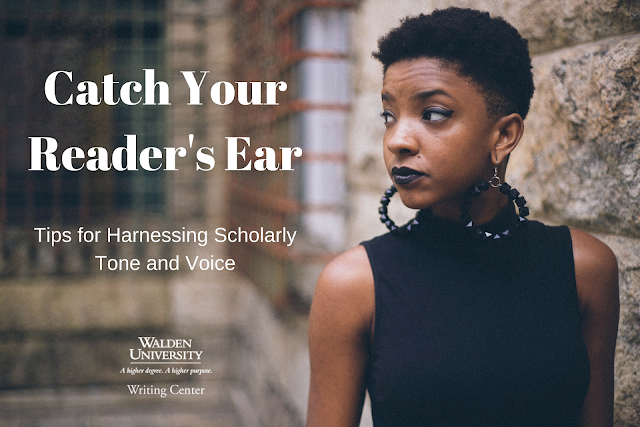Live Webinar Schedule for July 2018
Join us for one or all of our live webinars this coming month, with topics including: APA Style, Writing Center services, flow, and sentence structure . Students at Walden University don't take a summer break, so neither does our webinar schedule. Sign up today!Title: An Inside Look at Writing Center Paper Review Appointments
Date: Thursday, July 5, 2018
Time (Eastern): 2:00PM - 3:00PM
Audience: All Students
Title: APA Part 1: Method to the Madness
Date: Tuesday, July 10, 2018
Time (Eastern): 7:00PM - 8:00PM
Audience: All Students
Title: Cohesion & Flow: Bringing Your Paper Together
Date: Wednesday, July 18, 2018
Time (Eastern): 12:00PM - 1:00PM
Audience: All Students
Title: Engaging Your Reader with Sentence Structure
Date: Wednesday, July 25, 2018
Time (Eastern): 7:00PM - 8:00PM
Audience: All Students
Learn more about our webinars, view any of our archived webinar sessions, and find out how to suggest topics for future webinars by navigating to our Webinars Homepage.

The Walden University Writing Center presents weekly webinars on a range of topics related to scholarly writing, APA style, and the writing process. In addition to webinars, the writing center offers paper reviews, live chat, and a podcast to support writers during all stages of their academic careers.
.png)
Never miss a new post; Opt-out at any time
Catch Your Reader's Ear: The Simpler the Better for Scholarly Word Choice
“It appears the authors contrived a contextual audit of distinct, historical orators and their praxes in order to generate a conspectus of western rhetorical practices”
Yikes! I’m embarrassed to say this lengthy sentence can be found in my
first grad school assignment. I’m still
not sure I know what it means, and I don’t think I knew then either. Luckily, I
had a very patient professor that saw right through my attempt at sounding
collegiate. They told me that good writing didn’t mean long-winded sentences
full of multi-syllabic words I had looked up in a thesaurus. Again, Yikes.
Sure enough, I had written my
paper in (what I thought) was a good example of scholarly voice. It had been awhile since I had been in
school, and I was very self-conscious of my writing. I had no idea what my
professor expected of me in my first paper, and I couldn’t help but compare
myself to my peers. A number of them were in their second and third semesters
of grad school, and some had already been published in academic journals! I
thought I had to compensate for my inexperience by writing with complex jargon
and ideas, void of any individual style.
I couldn’t have been more wrong! Scholarly
writing is often viewed as dull and long-winded, but it doesn’t need to be. In
fact, the best examples of scholarly writing are clear and direct, and they use
concise language to inform and persuade.
However, like all forms of
writing, developing a scholarly voice requires practice. Although my professor
had explained where I went wrong with my first assignment, it took time and
practice to hone the rules of good scholarly writing. For example, I had to
learn to balance a formal tone with clarity and concision. In my example
sentence, the tone is formal, but the words themselves are unnecessarily
complex. To edit this sentence for clarity, I could replace the word
“contrived” with “created” and “praxes” with “habits.”
In fact, to edit this
sentence for scholarly voice, I would rewrite it as follows:
“The authors created a list of distinct, historical orators and their habits to create a summary of western rhetorical practices.”
While I substituted some of the
complex language for simpler ideas, the meaning of the sentence is still
obscured. For example, while authors could in fact “create a list of orators,”
the word “researched” better explains the authors’ specific actions. My second
revision is as follows:
“The authors researched a list of distinct, historical orators and their habits to create a summary of western rhetorical practices.”
Finding your scholarly voice takes
time and patience, and sometimes you have to accept help to discover your mistakes
and opportunities for improvement. However, the Writing Center’s staff is here to
support you through your journey. We get that scholarly writing is challenging
and can be intimidating, because we’ve been in your shoes! Eventually, we all
found our scholarly voice, and you will too.
Now it’s your turn! How would you revise
my sentence, “It appears the authors contrived a contextual audit of distinct,
historical orators and their praxes in order to generate a conspectus of
western rhetorical practices” for clarity and concision? Or, if you have a
personal example of a sentence you have edited for scholarly voice, please share
with us in the comments!
Tasha Sookochoff is a writing instructor in the Walden University Writing Center. Along with earning degrees from the University of Wisconsin, Stout and Depaul University, Tasha has written documentation for the U.S. House of Representatives that increases government transparency, blogged for DePaul University, copy-edited the Journal of Second Language Writing, tutored immigrants and refugees at literacy centers, and taught academic writing to college students.
.png)
Never miss a new post; Opt-out at any time
Transitioning into Your Final Doctoral Study?
Thursday, June 21, 2018
Capstone Writing
,
Dissertation
,
Expert Advice
,
Scholarly Writing
2 comments
It's been a long time coming. After all those courses,
discussion posts, projects, writing assignments, and time spent researching
topics in your field... you are finally moving into your final doctoral study.
Each degree program has its own requirements and series of documents, but many
follow this pattern: premise; prospectus; and final study, project, or
dissertation. Your program may not include all three of those or something may
go by another name. However, these documents are a big shift from the course
work you have been doing.
The Walden University Writing Center has many resources to
help you as you transition into these documents that are part of your final
doctoral study. Writing Center instructors are here to help you with your preproposal documents: the premise and prospectus. Let's take a look at some of those now.
- Here are webinars designed especially for the doctoral capstone writer. You may want to check out the one about moving from coursework into capstone writing. These webinars share tips about the specific documents you will be writing.
- Writing at this level can often feel lonely. The writing process for the capstone documents is sometimes done without the hustle, bustle, and interaction that comes with course work and discussion posts. On the podcast, we talk about the value of a writing community for academic writers.
- The first documents you work on will be the premise and/or prospectus, depending on your program. The Walden Writing Center offers a preproposal starter kit to walk you through these documents.
- If you are working on a premise or prospectus, you can still take advantage of our paper review service. Just be sure to choose the "preproposal schedule."
- When the day comes when your prospectus is approved and you begin work on the proposal, you will find all the help you need on the Walden Writing Center form and style page.
If you are looking for a specific type of supporting resource, please reach out and let us know. We will be happy to find it for you.
The Walden University Writing Center creates resources
for scholarly writers at all phases of their Walden University journey. We
cater to students just starting their coursework, all the way to students
finishing their capstone projects. Paper reviews, a podcast, a website,
modules, and live webinars are among just some of the resources we offer to
students.
.png)
Never miss a new post; Opt-out at any time
Catch Your Reader's Ear: Avoiding Bias and Increasing Sensitivity in Scholarly Writing
Note: This post has been updated per APA 7.Sensitivity in APA style can be a, well, sensitive subject. When we writing instructors receive questions in chat or in paper reviews about sensitivity, students often ask how to be sensitive in their writing—and what sensitivity even means in relation to APA style! The general definition of sensitive applies to APA style in a couple of different ways.
According to the dictionary, a sensitive person has “a quick and delicate appreciation of others’ feelings.” If you have researched how to avoid bias in APA-style writing, this definition makes sense. Sensitivity in APA style does relate to understanding and appreciating the feelings and thoughts of others. However, there is another definition for sensitive that can also be related to sensitivity in APA, and this definition is that a sensitive person is “quick to detect or respond to slight changes, signals, or influences.” You might be wondering how quickly responding to changes relates to APA style, so I’ll return to this second definition after talking a little bit about the general guidelines for avoiding bias and showing sensitivity in APA-style writing.
While there are many ways to ensure sensitivity when writing about groups of people, there are three overarching rules that you can follow to adhere to the APA-style guidelines for sensitivity:
Be specific. It can be tempting to use general terms in an attempt to be polite, but it is almost always best to avoid generalizing. For example, if a writer says, “I interviewed young children,” readers will wonder what constitutes “young.” Does the writer mean toddlers or preteens? If the writer instead says, “I interviewed participants between the ages of 5 and 10,” readers will have a stronger understanding of who the writer interviewed.
Keep terms parallel. It is also important to ensure use of parallel terms when describing groups of people. For example, it wouldn’t be parallel to research how women and males respond to video games. A scholar might instead use men and women. In fact, it’s a best practice to avoid using male and female as nouns in general because these terms are largely used as descriptors, such as when studying male and female penguins, for example.
Use a group’s preferred language. This rule is a little more difficult to follow because different people and different groups prefer different terms. For example, while people-first language is generally the standard for sensitivity in APA, some groups of people, such as autistic children, prefer the descriptor to be used first. It is always a best practice to research preferred descriptors and language when writing about a group of people.
There is one final rule not included in the above list because this rule is principal and supersedes the others: Accept change!
To ensure sensitivity in APA-style writing, it is important to understand that change is constant and that a change in preferred descriptors or language is generally a positive sign of a responsive academic community. For example, at one time, the norm in writing instruction was to only use “they” as a plural pronoun. However, due to changes in language preference in the LGBTQ+ community, we at the Writing Center updated our policy to illustrate our acceptance of gender-neutral pronouns. Change means progress, so being flexible and willing to comply with changing norms can help writers ensure sensitivity and avoid bias in writing.
To that end, the second definition of “sensitivity” that I linked above concerning being responsive to change should now make more sense in relation to sensitivity in APA. While it is important to be sensitive to others’ feelings, it is also important to respond quickly and gracefully to changes in preferred language. By always researching before writing about a specific group of people and by being considerate of changing norms, scholar-practitioners can help contribute to an inclusive atmosphere in academia.
Katherine McKinney is a writing instructor in the Walden University Writing Center. She received an M.A. in English from Valdosta State University in Valdosta, Georgia, and is currently pursuing a Ph.D. in Education at Walden. Katherine's goal as an instructor is to show students that the best writing results from practice, and she aims to provide feedback and resources that will guide students through the invention, composition, and revision process.
.png)
Never miss a new post; Opt-out at any time
Thursday Thoughts: On Writing Introductions Well
Why are introductions so hard to write? When should I write an introduction: before or after the draft has been written? I have a thesis statement, but where should I put it in my introduction? How do I give my reader a clear, concise preview of my essay? Do capstone projects have introductions?
Here in the Walden University Writing Center, we receive questions about writing introductions all the time. And students ask these questions for good reason: Introductions are important. They're not the most important element of your essay, but they are the first important element of your essay.
While the scope, length, and critical elements of your introduction will vary depending on the writing situation in which you find yourself, we've created some helpful resources that you can access as you need them. Take a look and follow the links below:
- Would a trained Writing Instructor leading you through a lesson on introductions be helpful? Click here and view our live webinar session on introductions, replete with plenty of opportunities to practice these useful skills
- Over the years on this blog, we've compiled many resources dedicated to introductions. Here's a post that answers one of the introduction-related questions above (Protip: use the search bar on the right to find all of our introduction posts)
- Our Walden Writing Center podcast, WriteCast, has a wonderful episode on avoiding the top-five introduction mistakes.
- And for you Walden University capstone writers out there, we've assembled a Doctoral Captsone Form and Style Kit called How Do I Introduce My Study.
Enjoy these resources, dear reader. We enjoyed creating them for you!

The Walden University Writing Center creates resources for scholarly writers at all phases of their Walden University journey. Students just starting their coursework, all the way to students finishing their capstone projects will find useful resources to help make them better writers today!
.png)
Never miss a new post; Opt-out at any time
Catch Your Reader's Ear: Verb Choice and Scholarly Voice
Monday, June 11, 2018
Expert Advice
,
Grammar and Mechanics
,
Word Choice
,
writing style
2 comments
If you want to level-up your scholarly voice, there’s one part of speech I recommend focusing on: verbs, the words that convey the action in each sentence. Today, let’s consider three different kinds of verbs that can make a big difference towards improving your scholarly writing.Avoid Verbs that Express Feelings
When you’re passionate about your topic, it’s tempting to bring your personal opinions into a paper. However, it’s best to avoid phrases such as “I believe,” “I think,” and “I feel” in academic writing. Because you’re the one writing the paper, your reader will safely assume that you believe, think, or feel what you’ve written. Furthermore, academic writing privileges research-based evidence over personal opinion.
Instead of writing an opinion, like this one:
I think that students need to pay more attention to what they read.Support your beliefs with evidence from your research:
Adler (1940) argued that most Americans did not understand what they read, so the author outlined a series of three reading strategies to aid comprehension.Your own opinions can be a great place to start, especially when choosing a topic, but it’s important to ground your academic writing in research and remain objective as a scholar.
Vary Verbs that Introduce
It’s often a good idea to introduce evidence with a brief contextualizing phrase. However, it can be tiresome to write “according to so-and-so” over and over again. To add some variety into your use of evidence, incorporate different kinds of verbs into these introductory phrases.
The way you compose your introductory phrases can also show your reader your own perspective on the evidence. If you agree with the source material, you might say the author concluded or proved, whereas if you disagree with it, you might say the author chose or justified. If you don’t have any feelings about it either way, you might say the author proposed or examined.
See this verb “cheat sheet” for a great list of verbs that you can use in your own writing.
Replace “to be” Verbs
To really make your writing more dynamic, try omitting all versions of the verb “to be.” These include be, am, is, are, was, were, been, and being. Instead, substitute verbs that better convey action. For example, take a look at this passage in which a student describes themself:
When I was a college student, I studied nursing and earned my BSN. After graduation, I was a nurse in an emergency department for 6 years. I am now a lead nurse in the emergency department of my hospital. I am interested in earning my MSN so that I am able to continue to advance my career and contribute to social change.Let’s find all of the “to be” verb conjugations. I have highlighted them below:
When I was a college student, I studied nursing and earned my BSN. After graduation, I was a nurse in an emergency department for 6 years. I am now a lead nurse in the emergency department of my hospital. I am interested in earning my MSN so that I am able to continue to advance my career and contribute to social change.Now, look at this revision, which avoids the “to be” verb:
I earned a BSN from Walden University. After graduation, I served as an emergency department nurse for 6 years. Now, I work as a lead nurse in the emergency department of my hospital. Earning my MSN will allow me to continue to advance my career and contribute to social change.I hope you’ll agree that the revised version is not only more concise, but also more interesting to read.
The next time you revise a piece of writing, I hope you’ll look at the verbs in your paper in a new light—they really can be key for making your writing sound more interesting and scholarly.
Cheryl Read is a Writing Instructor in the Walden
University Writing Center. Verbs that typically describe Cheryl include writing, parenting, hiking, and knitting.
.png)
Never miss a new post; Opt-out at any time
Catch Your Reader's Ear: A Five-Part Blog Series on Scholarly Tone and Voice
Note: This post has been updated per APA 7.One of the greatest challenges for scholarly writers is creating compelling, interesting prose that will encourage readers to engage with the writer's ideas. Unlike more informal genres of writing, scholarly prose covers topics, theories, and ideas that require precise, scientific description. Oftentimes, these descriptions are, by necessity, antithetical to the idea of captivating an audience. Plus, the formality valued in scientific research writing means the writer cannot rely on ornamental phrasing or grand spectacles of language to engross the reader.
So what methods do scholarly writers have at their disposal to engage their audience, to catch their reader's ear?
Here at the Walden University Writing Center, our answer to that is writers can write engaging, compelling, interesting prose by harnessing a clear and confident scholarly tone and voice. As writers present their evidence-based research to their readers, there are a number of strategies that can be used to compel readers to engage with their work.
To help writers learn and utilize these strategies, we would like to present a five-part blog series that delves into this topic. Each post in this series will introduce, explain, and put into practice a writing strategy that will help writers harness a scholarly tone and practice using their scholarly voice. We hope these topics will be interesting and helpful to you as you develop your own methods to Catch Your Reader's Ear!
Join us for each part in this series for tips to help you harness your scholarly tone and voice
We hope you will enjoy this blog series and learn from the strategies each Instructor presents. Please let us know in the comments if there are any other scholarly voice-related topics you'd like us to address in future posts.
Until then: Keep writing. Keep inspiring!

The Walden University Writing Center seeks to teach writer's what scholarly writing is, and how to deploy it as a strategic communicative device. Scholarly writing, like all forms of writing, has certain features that are unique to it and that its readers expect to encounter. Once a writer understands and can utilize those features, scholarly writing becomes another tool that can enhance the effectiveness of the writer's expression. This blog series strives to build these skills and understandings.
.png)
Never miss a new post; Opt-out at any time
Catch Your Reader's Ear: Using Sentence Structure to Enhance Scholarly Tone
Monday, June 04, 2018
Expert Advice
,
Grammar and Mechanics
,
Scholarly Writing
,
Word Choice
,
writing style
6 comments
Scholarly voice is important for several reasons. As a Writing Instructor, I encourage writers to practice clarity of expression and writing concisely in their work, which means that sentences are clear and words are used economically. However, when writers focus solely on these two characteristics of scholarly voice readers can be left with more questions than answers as they read over previous sentences to understand the next sentence.
Ambiguous Subjects Lead to Unclear Sentence Structures
Before discussing the use of ambiguous subjects for sentences, it might help to take a quick refresher on basic sentence structure. The structure for clear and complete sentences is subject à verb à object.
Note: Throughout this post, the highlighting and font styles in the "examples" correspond to the parts of the sentence: yellow highlighting in bold type (subject); green highlighting in underlined type (verb); blue highlighting in italicized type (object).
Example: Nurse practitioners would benefit from emotional intelligence training to ensure that they cultivate a community of trust and respect among nursing staff.
When using this sentence structure, the subject of the sentence, nurse practitioners, is specific; thus, the point is clear for readers. However, what happens when the sentence that follows includes a subject that is more ambiguous?
Example: Nurse practitioners would benefit from emotional intelligence training to ensure that they cultivate a community of trust and respect among nursing staff. It can also support relationships between nurses and their patients.
Wait, what does “it” refer to here? The subject of the last sentence was nurse practitioners, so the use of an ambiguous subject in this sentence makes it hard for readers to know exactly what “it” refers to since “it” doesn’t have a clear antecedent (it is not clearly connected to a subject). “It” could refer to nurse practitioners, but the reader doesn’t know for sure. It could refer to “emotional intelligence.” “It” could refer to “training.” Without a specific subject, the reader is left to guess. And since clear, direct, specific prose are important characteristics of scholarly voice, forcing the reader to guess creates non-scholarly voice.
Instead of referring back to previous terms, topics, and subjects using ambiguous pronouns, I recommend that writers write clear, direct, unquestionable subjects into all of their sentences. “It,” “this,” and “that” might seem like scholarly shortcuts to achieving economy of expression, but be careful. The more your reader has to guess as to what you mean, the less scholarly your writing voice becomes.
Passive Voice Leads to Unclear Sentence Structures
While APA warns about the use of “it” and other less specific subjects for sentences, the style guide also warns about passive voice, which can occur when the subject of the sentence is proceeded by the verb. Structuring sentences in this way creates passive constructions because it is often unclear who or what is acting on the verb For instance, let’s say you want to paraphrase an author:
Example: It was argued that emotional intelligence training can also support relationships between nurses and their patients (Minton, 2018).
Since “it” doesn’t create a clear and specific subject, this sentence is already in danger of falling into the passive voice. We also can’t answer the question “who did the arguing,” which makes the subject of this sentence further obscured. Clearly, the lack of specificity and precision in this sample sentence stands in the way of the reader’s understanding.
Let’s look at how slight changes to the sentence structure can improve the reader’s understanding, thereby enhancing the writer’s scholarly voice. Recall the structure for clear and complete sentences: subject à verb à object
Let’s start by finding a clear subject for this sentence. Since “argued” is our verb, ask yourself, who did the arguing? Yes, Minton! Therefore “Minton,” the author of this information, is a clear and specific subject for our sentence. Let’s move the subject to the fore of the sentence and see how that creates a clearer, more scholarly sentence.
Example: Minton (2018) argued that emotional intelligence training can also support relationships between nurses and their patients.
Notice that not only the subject of the sentence is specific, but the rest of the points in the sentence are specific as well to ensure clarity of expression and connection and flow among points.
Example: Nurse practitioners would benefit from emotional intelligence training to ensure that they cultivate a community of trust and respect among nursing staff (Minton, 2018). Minton (2018) argued that emotional intelligence training for nurses can also support relationships between nurses and their patients.
In conclusion, while the use of some pronouns, such as “it,” are acceptable in APA style scholarly writing, these pronouns need to be clearly connected to a subject within the sentence and should not result in passive voice.
We’d love for you to share with us an example of the appropriate use of “it” in a sentence or let us know what other pronoun use complicates the clarity of a sentence. And stay tuned to the blog in the upcoming weeks as we continue our exploration of scholarly voice and tone.
Veronica Oliver is a Writing Instructor in the Walden Writing Center. In her spare time she writes fiction, binge watches Netflix, and occasionally makes it to a 6am Bikram Yoga class.
.png)
Never miss a new post; Opt-out at any time
Subscribe to:
Posts
(
Atom
)















No comments :
Post a Comment